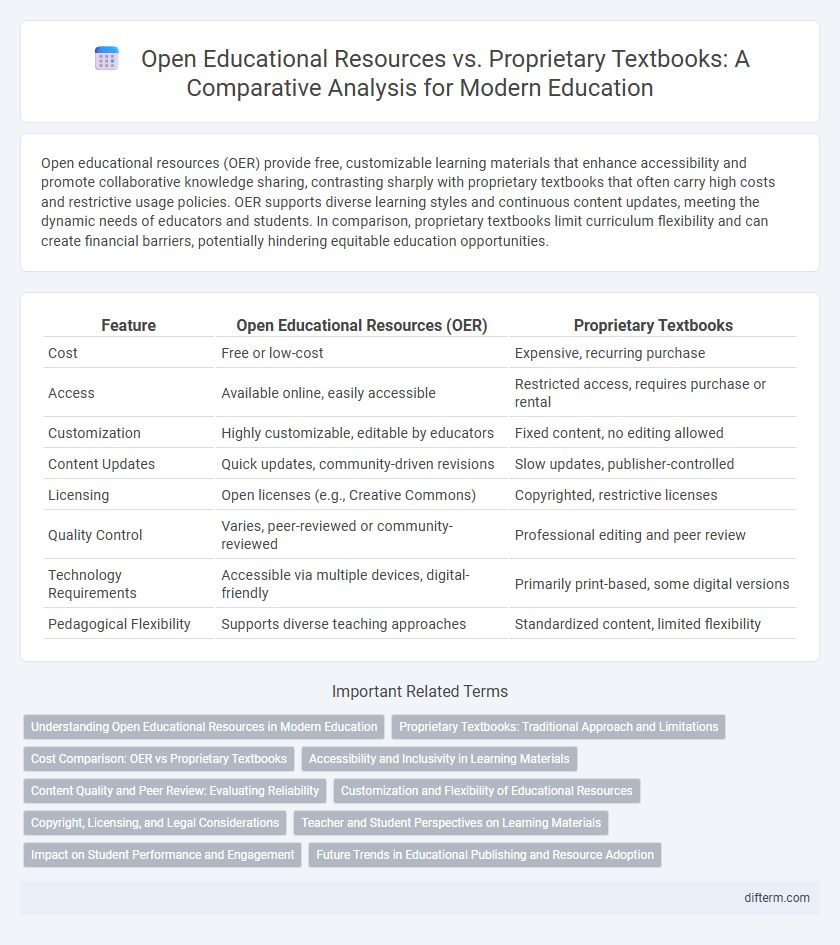Open educational resources (OER) provide free, customizable learning materials that enhance accessibility and promote collaborative knowledge sharing, contrasting sharply with proprietary textbooks that often carry high costs and restrictive usage policies. OER supports diverse learning styles and continuous content updates, meeting the dynamic needs of educators and students. In comparison, proprietary textbooks limit curriculum flexibility and can create financial barriers, potentially hindering equitable education opportunities.
Table of Comparison
| Feature | Open Educational Resources (OER) | Proprietary Textbooks |
|---|---|---|
| Cost | Free or low-cost | Expensive, recurring purchase |
| Access | Available online, easily accessible | Restricted access, requires purchase or rental |
| Customization | Highly customizable, editable by educators | Fixed content, no editing allowed |
| Content Updates | Quick updates, community-driven revisions | Slow updates, publisher-controlled |
| Licensing | Open licenses (e.g., Creative Commons) | Copyrighted, restrictive licenses |
| Quality Control | Varies, peer-reviewed or community-reviewed | Professional editing and peer review |
| Technology Requirements | Accessible via multiple devices, digital-friendly | Primarily print-based, some digital versions |
| Pedagogical Flexibility | Supports diverse teaching approaches | Standardized content, limited flexibility |
Understanding Open Educational Resources in Modern Education
Open Educational Resources (OER) provide free, accessible, and customizable learning materials, promoting greater equity and flexibility compared to costly proprietary textbooks. These resources support diverse learning styles through adaptable digital formats, enhancing student engagement and success. Integration of OER in modern education reduces financial barriers, enabling institutions to allocate resources towards innovative teaching and learning strategies.
Proprietary Textbooks: Traditional Approach and Limitations
Proprietary textbooks, controlled by publishers, often come with high costs that limit accessibility for many students. These textbooks are periodically updated, but the fixed content may not address diverse learning needs or current curriculum changes effectively. Licensing restrictions prevent customization and sharing, creating barriers to flexible and inclusive education.
Cost Comparison: OER vs Proprietary Textbooks
Open Educational Resources (OER) offer significant cost savings compared to proprietary textbooks, with many free or low-cost digital options available to students. Proprietary textbooks often come with high price tags, ranging from $60 to over $200 per book, creating financial barriers for students. Schools adopting OER can reduce expenses while maintaining quality content, improving accessibility and equity in education.
Accessibility and Inclusivity in Learning Materials
Open educational resources (OER) significantly enhance accessibility by offering free, customizable learning materials available to a diverse range of students, including those with disabilities and from low-income backgrounds. Proprietary textbooks often limit inclusivity due to high costs and rigid formats that may not support adaptive technologies or diverse learning needs. Emphasizing OER adoption can bridge educational gaps by providing equitable access and fostering a more inclusive learning environment across various institutions.
Content Quality and Peer Review: Evaluating Reliability
Open educational resources (OER) undergo continuous peer review and updates by a diverse community of educators, enhancing content quality and ensuring current, accurate information. Proprietary textbooks are typically reviewed by expert committees and undergo rigorous editorial processes, but content updates occur less frequently due to publishing cycles. Evaluating reliability involves considering the transparency of the review process and the consistency of revisions that maintain accuracy and relevance in educational materials.
Customization and Flexibility of Educational Resources
Open educational resources (OER) provide unparalleled customization and flexibility by allowing educators to modify content to fit diverse learning styles and evolving curricula. Unlike proprietary textbooks, which are often fixed in format and content, OER can be adapted to include localized examples, updated information, and accessible formats, enhancing student engagement and comprehension. This adaptability supports personalized learning environments and promotes inclusive education by meeting the specific needs of individual learners and institutions.
Copyright, Licensing, and Legal Considerations
Open educational resources (OER) provide flexible copyright and licensing options through Creative Commons licenses, allowing educators to legally adapt, share, and distribute materials without infringement risks. Proprietary textbooks, governed by strict copyright protections, restrict usage, modification, and redistribution, often leading to higher costs and limited accessibility. Understanding the legal frameworks surrounding OER versus proprietary content is critical for educational institutions to ensure compliance and promote open access.
Teacher and Student Perspectives on Learning Materials
Teachers appreciate open educational resources (OER) for their flexibility and adaptability, allowing tailored content to meet diverse student needs, while proprietary textbooks often provide structured, vetted curriculum content. Students benefit from OER through free and immediate access to updated materials, promoting equity and inclusivity, whereas proprietary textbooks may impose financial barriers and limit resource availability. The contrasting perspectives underscore the value of OER in fostering personalized and cost-effective learning experiences versus the consistent reliability of proprietary textbooks.
Impact on Student Performance and Engagement
Open educational resources (OER) provide diverse, customizable content that enhances student engagement through interactive and up-to-date learning materials, often resulting in improved academic performance compared to proprietary textbooks. Studies reveal that OER usage reduces financial barriers, allowing wider access and increased motivation, which contributes positively to learning outcomes. Proprietary textbooks may offer curated, high-quality content but often lack flexibility and adaptability, potentially limiting students' active participation and personalized learning experiences.
Future Trends in Educational Publishing and Resource Adoption
Open educational resources (OER) are rapidly transforming educational publishing by promoting cost-effective, customizable, and accessible learning materials that support diverse learning needs. Proprietary textbooks continue to evolve with enhanced interactive features, digital platforms, and adaptive learning technologies that cater to personalized education experiences. Future trends indicate a hybrid adoption model where institutions leverage both OER's flexibility and proprietary content's technological advances to optimize educational outcomes.
open educational resources vs proprietary textbooks Infographic

 difterm.com
difterm.com